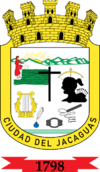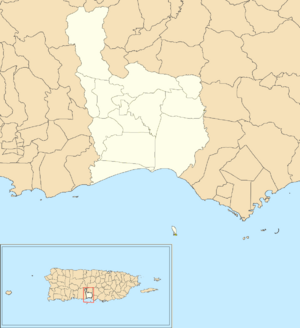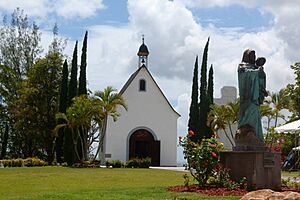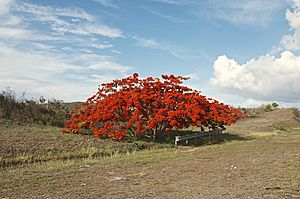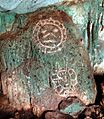Juana Díaz, Puerto Rico facts for kids
Quick facts for kids
Juana Díaz
|
|||
|---|---|---|---|
|
Town and Municipality
|
|||
| Municipio Autónomo de Juana Díaz | |||
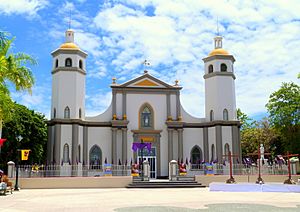
San Ramon Nonato Church and main town square in Juana Díaz
|
|||
|
|||
| Nicknames:
"La Ciudad del Maví", "La Ciudad del Jacaguas", "El Belén de Puerto Rico"
|
|||
| Anthem: "Juanadinos, alcemos las voces" | |||

Map of Puerto Rico highlighting Juana Díaz Municipality
|
|||
| Sovereign state | |||
| Commonwealth | |||
| Settled | 1582 | ||
| Founded | April 25, 1798 | ||
| Founded by | Don Diego Vázquez | ||
| Barrios | |||
| Area | |||
| • Total | 107.04 sq mi (277.23 km2) | ||
| • Land | 60.29 sq mi (156.15 km2) | ||
| • Water | 46.75 sq mi (121.08 km2) | ||
| Population
(2020)
|
|||
| • Total | 46,538 | ||
| • Rank | 17th in Puerto Rico | ||
| • Density | 434.776/sq mi (167.868/km2) | ||
| Demonym(s) | Juanadinos | ||
| Time zone | UTC−4 (AST) | ||
| ZIP Code |
00795
|
||
| Area code(s) | 787/939 | ||
| Major routes | |||
Juana Díaz is a vibrant town and municipality located on the southern coast of Puerto Rico. It sits near the Caribbean Sea, east of Ponce and west of Coamo. The town is divided into 13 main areas called barrios, plus the downtown area known as Juana Díaz Pueblo.
Juana Díaz is famously called "La Ciudad del Maví," which means "Maví City." Mabi is a special drink made from the bark of the mavi tree. It's a traditional fermented drink from the Taíno people.
Contents
History of Juana Díaz
Juana Díaz was officially founded in 1798. It was once known as Ciudad de Jacagua, named after the Taíno leader Cacique Jacaguax. The local government started on April 25, 1798.
After the Spanish–American War, Puerto Rico became a territory of the United States in 1898. A census in 1899 showed that Juana Díaz had a population of 27,896 people.
In 2017, Hurricane Maria caused a lot of damage to the island. In Juana Díaz, about 2,500 homes lost their roofs.
Geography and Nature
Juana Díaz is located on Puerto Rico's southern coast. Several rivers flow through the area, including the Río Inabón and the Río Jacaguas. The town gets its nickname, "Ciudad del Jacaguas," from this river.
The Guayabal dam is on the Río Jacaguas, between Juana Díaz and Villalba. Another important river is the Río Toa Vaca, which also has a dam. Both Guayabal and Toa Vaca are important lakes in the area. Lake Toa Vaca provides drinking water for Juana Díaz, Ponce, and other nearby towns. The highest point in the municipality is near Cerro Maravilla.
Exploring Juana Díaz's Barrios
Like all municipalities in Puerto Rico, Juana Díaz is divided into smaller areas called barrios. The main town square, government buildings, and the large Catholic church are all found in the barrio known as "el pueblo".
Here are the barrios of Juana Díaz:
- Amuelas
- Callabo
- Capitanejo
- Cintrona
- Collores
- Emajagual
- Guayabal
- Jacaguas
- Juana Díaz barrio-pueblo
- Lomas
- Río Cañas Abajo
- Río Cañas Arriba
- Sabana Llana
- Tijeras
Special Communities in Juana Díaz
Some areas in Puerto Rico are known as Comunidades Especiales de Puerto Rico (Special Communities). These are communities where citizens might face social challenges. In Juana Díaz, some of these special communities include Arús (Pastillito), Callejón de los Perros (Los Buenos), Sector San Carlos in Collores, Sector Baldío in Cuevas, La Atómica, Las Palmas, and Manzanilla.
Population of Juana Díaz
| Historical population | |||
|---|---|---|---|
| Census | Pop. | %± | |
| 1900 | 27,896 | — | |
| 1910 | 29,157 | 4.5% | |
| 1920 | 18,529 | −36.5% | |
| 1930 | 19,516 | 5.3% | |
| 1940 | 23,396 | 19.9% | |
| 1950 | 27,697 | 18.4% | |
| 1960 | 30,043 | 8.5% | |
| 1970 | 36,270 | 20.7% | |
| 1980 | 43,505 | 19.9% | |
| 1990 | 45,198 | 3.9% | |
| 2000 | 50,531 | 11.8% | |
| 2010 | 50,747 | 0.4% | |
| 2020 | 46,538 | −8.3% | |
| U.S. Decennial Census 1899 (shown as 1900) 1910-1930 1930-1950 1960-2000 2010 |
|||
The people who live in Juana Díaz are called "Juanadinos." The population of Juana Díaz has changed over the years. In 2020, the total population was 46,538.
Fun Places to Visit in Juana Díaz
If you're looking for fun things to do, the Puerto Rico Tourism Company suggests visiting these places in Juana Díaz:
- Casa Museo de los Santos Reyes (Three Kings Museum)
- Salto de Collores (Collores Waterfall)
- Casa de la historia Juanadina José Rafael Gilot (Juana Díaz History House)
Landmarks and Attractions
Juana Díaz has many interesting places to see, including about 30 beaches!
- Iglesia San Ramón Nonato: A beautiful church.
- Guayabal Reservoir: A large lake formed by a dam.
- Holy Kings Monument: A monument dedicated to the Three Kings.
- Lucero Cave: A cave with interesting carvings.
- Plaza Román Baldorioty de Castro: The main town square.
- Schoenstatt Shrine: A peaceful religious site.
Economy and Resources
In the past, Juana Díaz was well-known for growing a lot of sugarcane. However, that industry has changed over time.
Agriculture in Juana Díaz
Today, Juana Díaz grows many different crops. These include plantains, bananas, and mangoes. These fruits are sold in local markets and also sent to other countries. Farmers in Juana Díaz also raise cattle and pigs.
Local Industry
Juana Díaz is special because it produces beige marble. This type of marble is known as one of the finest in the world.
Culture and Celebrations
Festivals and Events
Juana Díaz loves to celebrate! One of the biggest events is the Fiestas Patronales de San Ramón Nonato, which is the town's patron saint festival. It happens in late August or early September. This festival includes parades, games, local crafts, fun rides, delicious food, and live music.
Other exciting festivals and events in Juana Díaz include:
- The Three Kings Festival: This is the largest Three Kings Festival in all of Puerto Rico! It's celebrated on January 6th. This religious and cultural event started in 1884. It celebrates the visit of the Three Kings to baby Jesus. The main part is a parade down Comercio Street to the town's plaza. There, a large altar is set up for a special church service. The service tells the story of the prophets announcing the coming of the Messiah, followed by the shepherds seeing the three kings. The service ends with the Three Kings finding and adoring baby Jesus. Some people even dress up as shepherds for the festival!
- Festival del Mabí (Mauby Festival): Celebrated in March.
- Bull Frog Festival: Held in April.
- Good Friday: Juana Díaz has many activities during Holy Week each year. The most famous is the Good Friday procession. It goes through many parts of the town with people acting out the Stations of the Cross. Thousands of people visit Juana Díaz on Good Friday.
- Llorensiana Week: Celebrated in May.
- Puerto Rican Festivities: Held in December.
Symbols of Juana Díaz
The municipality of Juana Díaz has its own official flag and coat of arms, which represent its history and culture.
The Flag of Juana Díaz
The flag of Juana Díaz is shaped like a rectangle. It has two triangles. One triangle is white, located in the upper left corner. The other triangle is yellow or gold, in the lower right corner. In the middle of the flag, you can see the coat of arms of Juana Díaz with all its natural colors.
The Coat of Arms
The coat of arms of Juana Díaz tells a story about the town.
- The Nazarene Cross: This cross is in the center. It shows how two cultures came together through the Christian faith. It also represents Western Christian culture.
- The Woman: This part of the coat of arms shows Mrs. Juana Díaz, who the town is named after. She is scattering thirteen grains of corn into thirteen furrows. This symbolizes the seeds that grew and helped found the town. She is dressed in clothes from her time.
- The Sun: The sun represents new beginnings and hope for the town. It has thirteen rays, and each ray stands for one of the thirteen barrios of Juana Díaz.
- Thirteen Knolls: These small hills also represent the thirteen barrios of Juana Díaz. They also show that Juana Díaz was once rich in minerals.
- The Indians: These figures represent the native people who lived in the area before Europeans arrived. The native carries thirteen arrows and a bow, showing their means of defense.
- The Shackle and Whip: These symbols remind us of a difficult time in 1887. They represent a harsh military rule called "El Componte" that was used to silence people who wanted freedom. Juana Díaz was a place where many brave people fought against this unfair rule.
- The Harp and Quill Pen: The harp represents music, and the quill pen with ink represents writing and poetry. Juana Díaz has been home to many talented poets.
- Ciudad del Jacaguas: This was an old name for Juana Díaz. The famous poet Luis Lloréns Torres also called it "La Versalles de Ponce" (Ponce's Versailles).
- Four Castles: These castles show that Juana Díaz has grown to be a significant city. Cities usually have five castles on their coat of arms, while villages have four, and smaller towns have three.
Getting Around Juana Díaz
Juana Díaz has important roads that connect it to other parts of Puerto Rico.
- The Luis A. Ferré Expressway (PR-52) quickly connects Juana Díaz to Ponce and its airport. You can reach San Juan in about an hour.
- Road PR-14 goes through downtown Juana Díaz, connecting Ponce and Cayey.
- Road PR-149 runs from Juana Díaz to Manatí, passing through Villalba and the central mountains.
- Road PR-1 goes from Ponce to San Juan, passing through the community of Pastillo on the south coast.
There are 51 bridges in Juana Díaz, helping people travel across rivers and valleys.
Famous People from Juana Díaz
People from Juana Díaz are called "Juanadinos." Here are some notable people from the town:
- Tito Gomez: A famous salsa singer.
- Luis Lloréns Torres: A well-known Puerto Rican poet and essayist.
- Guillermo Jose Torres: A respected Puerto Rican reporter and news anchor.
- Héctor Tricoche: A salsa singer known for his work with the Tommy Olivencia Orchestra.
- Dalex: A popular reggaeton singer.
Images for kids
See also
 In Spanish: Juana Díaz para niños
In Spanish: Juana Díaz para niños



